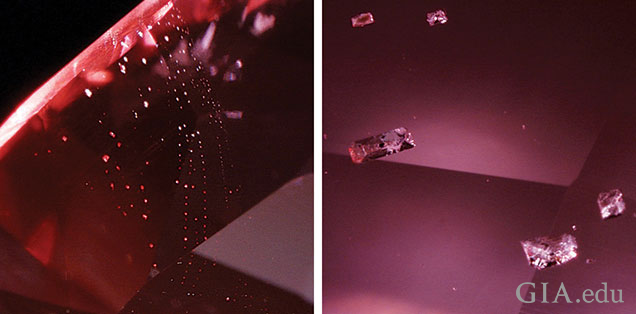Purplish Pink Spinel from Tajikistan: Before and After Cutting

In December 2007, Pakistan-based client Syed Iftikhar Hussain submitted a parcel of spinel rough reportedly from Tajikistan (figure 9, left). These 84 samples, the largest weighing 48.5 g, exhibited varying saturations of purplish pink color. Little has been written on the properties of Tajik spinel (see, e.g., J. I. Koivula and R. C. Kammerling, “Examination of a gem spinel crystal from the Pamir Mountains,” Zeitschrift der Deutschen Gemmologischen Gesellschaft, Vol. 38, 1989, pp. 85–88), so in November 2008 the Bangkok laboratory was fortunate to have an opportunity to briefly examine seven stones that the client had faceted from this parcel (figure 9, right).
Most of the original rough consisted of broken pieces, and only a few showed the octahedral crystal forms typical of spinel. We could not perform accurate RI measurements because of the lack of flat surfaces, so we had to rely on other tests. The hydrostatic SG measurements, spectra seen with a handheld spectroscope, polariscope reactions, and UV fluorescence were consistent with spinel. These observations were further substantiated by PL spectroscopy (514 nm laser excitation at room temperature) on the largest piece, which proved it was natural spinel. The most prominent inclusions seen in the samples were euhedral crystals, needles, and crystals with white particulate trails forming “comet tails” (figure 10).
After the rough was cut, we obtained standard gemological properties for the seven faceted stones. The results were fairly consistent: RI— 1.712–1.713, SG—3.59–3.62, strong red fluorescence to long-wave UV radiation and weak red to weak-tomoderate orange (some with a chalky greenish cast) fluorescence to shortwave UV, and a characteristic “organ pipe” spectrum (with some general absorption in the orange/yellow and part of the green region) seen with the spectroscope. While the refractive indices were almost identical to that of the crystal detailed by Koivula and Kammerling (and a Tajik spinel reported in the Spring 1989 Lab Notes, pp. 39–40), the SGs varied slightly.

Since the cleanest pieces of rough were likely selected for faceting, it was no surprise that six of the cut stones showed few inclusions. The 11.96 ct pear shape hosted the most internal features, which consisted of a plane of octahedral negative crystals and some euhedral crystals (figure 11). Tiny negative crystals were only faintly visible in one other stone. Unfortunately, there was no time to identify inclusions in either the rough or cut spinels with Raman spectroscopy. The PL spectrum of the pear-shaped stone closely matched that of the rough sample.



